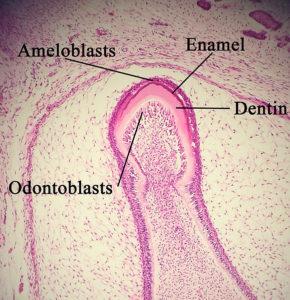Originally posted April 23, 2015
One of Dr. Glaros’ colleagues recently told us about a man who had contacted his office about getting his mercury amalgam fillings removed. He said he didn’t want them replaced, though. When asked why, he said that he was going to “remineralize” his teeth instead. He’d read all about it online.
Whether this prospective patient misunderstood or had simply encountered inaccurate information, the fact remains: Remineralization is not the same thing as regrowing teeth – just as fertilizing soil (to restore lost nutrients) is different from creating new soil.
Remineralization is the process of restoring calcium and other minerals that have been lost to the acids generated by oral pathogens (“bad bugs”) or dietary acids we consume. That demineralization is constantly happening. Consequently, remineralization is – or should be – an ongoing process, and as we’ve discussed before, there are nutritional changes you can make to support that process. Homeopathic remedies can also be helpful in making sure our bodies can efficiently use the minerals we consume.
If the enamel becomes significantly eroded, though, it’s a different story.
 For starters, it is biologically impossible to naturally regrow tooth enamel. Enamel is created by specialized cells called ameloblasts, which are present in each tooth bud – the mass of tissue that, over time, develops into a tooth. Ameloblasts secrete proteins and later transport minerals that eventually harden. Once the enamel has fully formed, these cells die.
For starters, it is biologically impossible to naturally regrow tooth enamel. Enamel is created by specialized cells called ameloblasts, which are present in each tooth bud – the mass of tissue that, over time, develops into a tooth. Ameloblasts secrete proteins and later transport minerals that eventually harden. Once the enamel has fully formed, these cells die.
No more ameloblasts, no more enamel production.
Thus, much current stem cell research is focused on producing new ameloblasts. Other research looks to develop materials that could mimic enamel in some way. In either case, it’s a matter of bioengineering new tooth structure – doing something our bodies are unable to do on their own.
But while it is impossible to grow new enamel, it is possible to stop the decay process. Improved nutrition – replacing sugar and other refined carbohydrates with more nutrient-dense food and adding supplements as needed – goes a long way toward that. If a cavity is on the biting surface and caught early enough, treatments like micro air abrasion and ozone can be used to remove the decay and stop the disease process, no drilling or filling necessary.
This is one of the reasons why early detection technologies such as Diagnodent are so valuable. We can catch decay when it’s still easily treatable by non-invasive means.
And if decay is advanced? We can remove the decay and restore the tooth, of course. And as Dr. Weston Price showed many decades ago, a certain kind of self-repair is possible under optimal nutritional conditions. If freely exposed to saliva that contains a proper balance of minerals, the spongy, leathery dentin grows hard. It’s a process Dr. Price likened to petrification. The dentin doesn’t grow to completely fill in the cavity, but once mineralized, it does provide a protective barrier for the tooth. The tissue will be darker and rough against the existing enamel. It will no longer be living tissue. But loosely speaking, the tooth may be considered healed.
That said, there of course happens to be an even better “cure” for cavities: keep them from developing in the first place.
To focus so much on “curing tooth decay” is to focus merely on mitigating or limiting damage – just as mainstream dentistry has done through its obsession with things like fluoride and sealants. It gives us a way to shirk a lot of responsibility for our choices.
That may sound like “Dr. Fun-Wrecker” talking, as Dr. Glaros likes to put it. Then he gives this analogy:
I do not want research and progress on curing lung cancer to stop. That said, we do have rather strict laws that appear to be relatively well-enforced, without public outcry, about children smoking cigarettes.
Yet there are folks who seem to think it’s no problem to feed sugary junk to kids all day, then insist on a strict brushing routine before bedtime. It seems like lighting cigarettes for them all day long, then insisting on 50 push-ups before bedtime.*
We know plenty about the effect of sugar on teeth and health. Sugar has a systemic, predictable, negative effect on metabolism that cannot be undone by any level of home care.
I am blessed with the love and respect of my wife Joanne, five adult children, and now four grandkids. I don’t want to be insensitive, judgmental, or offensive to these whom I love the most. Our newest grandchild arrived just last week. What an angel; what a story she already has to tell! If she is treated like the others, she will be breast fed for well over a year, with her mom on a strict diet that honors her baby to a wonderful extreme: organic food for Mom, goat milk or whatever family beliefs appear to be in her best interest.
When will the “junk” food slither in? I don’t really know, but it does.
Still, that’s no reason to quit trying to do better. We can always do better.
* Lest this sound too extreme, eminent researchers such as pediatric endocrinologist Dr. Robert Lustig contend that added sugar’s damage to health is so great and its effects, so pernicious, that sugar should be regulated in the same manner as tobacco and alcohol. For more, see his commentary in the esteemed journal Nature, “The Toxic Truth about Sugar,” as well as Gary Taubes’ New York Times Magazine piece “Is Sugar Toxic?”
Image by dozenist, via Wikimedia Commons